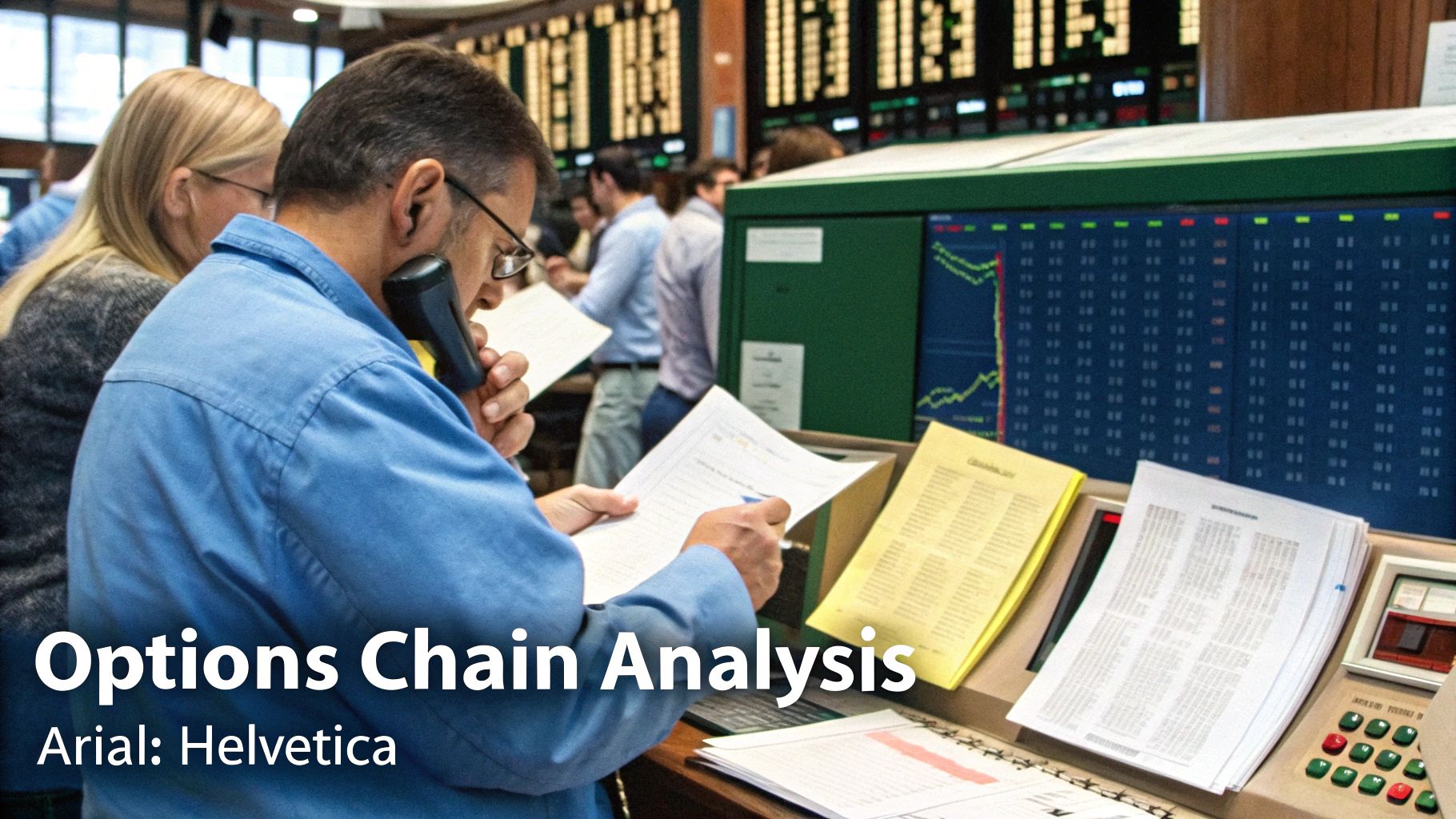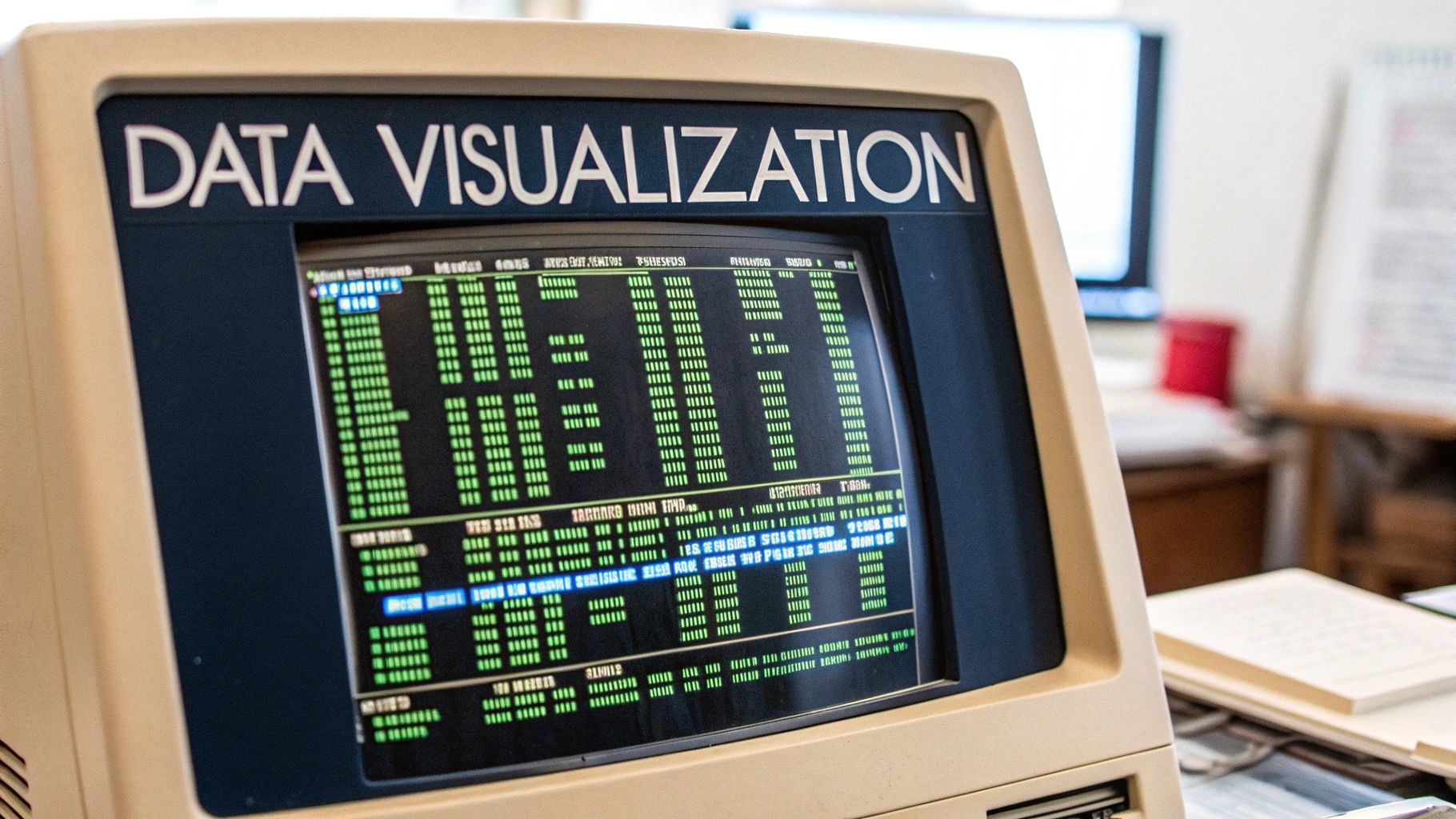The Hidden Power of Historical Options Data

When it comes to trading success, historical options chain data offers much more than simple price history. Expert traders know that this data contains valuable patterns and insights that can meaningfully improve their decision-making. By studying how options behave across different market environments, traders gain a deeper understanding of stock and ETF price movements. This detailed analysis helps them spot opportunities that others might miss when only looking at basic indicators.
Uncovering Market Sentiment Through Time
Historical options data lets traders peek into past market psychology and behavior. Just as geologists study rock layers to understand Earth's history, traders can examine historical options data to understand how markets evolved. By looking at changes in metrics like open interest and trading volume across different strike prices and expiration dates, we can see how market sentiment shifted during specific periods. For instance, tracking these patterns helps identify times when markets became extremely bullish or bearish, offering clues about potential reversal points. The relationship between past implied and realized volatility also provides useful signals about future price direction.
Backtesting Strategies With Historical Data
Before risking real money on a new trading approach, historical options data allows thorough strategy testing. Think of it like a flight simulator for pilots – you can practice and refine your techniques without real-world consequences. For example, if you want to try a covered call strategy on a particular stock, you could test it against the last five years of market data first. This gives you clear evidence of how the strategy performed in different conditions and helps you adjust your approach based on actual results rather than theories.
Avoiding Common Pitfalls With Historical Insights
Learning from the past helps traders sidestep costly mistakes in the present. By studying how options performed during previous market crashes and volatile periods, traders develop better risk management skills. The data shows exactly how different options strategies held up under stress, highlighting potential weaknesses to address. Resources like FirstRate Data provide an extra advantage by including data from delisted securities, showing how options behaved when companies faced serious problems. With detailed information about bid-ask spreads, implied volatility, and options Greeks across more than 5,000 tickers since 2010, traders can build a complete picture of market behavior. This knowledge helps them make smarter choices about position sizing, strategy selection, and risk control – essential skills for long-term trading success.
Decoding Options Chain Structure Like a Pro
Think of historical options chain data as a detailed financial map that tracks market movements over time. Learning to read this map helps you understand past market behavior and make more informed trading decisions. The consistent structure of options chains makes it possible to spot patterns and analyze trends across different time periods.
Understanding the Layout: Expiration and Strike Price
Options chain data follows a clear organizational system, similar to how a spreadsheet organizes information. The data is first sorted by expiration date, then by strike price, making it simple to find specific contracts. For instance, when looking at Apple options from June 2023, you'll see all calls and puts for that month grouped together. The strike prices are arranged in order within each expiration date, giving you a clear view of available options and their key metrics at any point in time.
Key Data Points: Bid-Ask Spreads and Volume
Every element in the options chain tells part of the market's story. The bid-ask spread shows how much buyers are willing to pay versus what sellers want – a smaller gap usually means the option trades easily, while a bigger gap suggests it might be harder to trade quickly at a good price. By studying how these spreads changed in the past, you can better understand which options typically trade smoothly and which ones might cost more to get in and out of. Trading volume adds another layer to this picture, showing you when market activity peaked and dropped.
Open Interest and Its Significance
Open interest gives you a count of active option contracts, much like tracking attendance at an event. When open interest is high, it shows many traders are involved with that particular option. Low open interest suggests fewer traders are participating. This information becomes especially useful when you notice changes – a sudden increase in open interest at certain strike prices often means traders are taking new positions, though it doesn't tell you if they're betting on prices going up or down. Smart traders look at open interest alongside volume and bid-ask spreads to get the full picture of market activity. This combined view helps explain why certain options became popular or fell out of favor at different times, offering valuable context for current trading decisions.
Mastering the Volatility Landscape

While reading an options chain and tracking open interest are essential skills, success in options trading comes from deeply understanding volatility. Historical options data is a powerful tool that gives traders insight into how volatility has behaved over time for specific assets. This background helps predict market movements and find options that may be incorrectly priced by the market.
Understanding Volatility Surfaces
The volatility surface is one of the best ways to visualize historical options data. This 3D graph shows how implied volatility relates to both strike price and time until expiration. Looking at past volatility surfaces reveals patterns that aren't obvious when examining single options contracts. For example, when out-of-the-money puts show higher implied volatility than out-of-the-money calls (known as volatility skew), it often signals that traders expect the market to move lower. Watching how this skew pattern changes provides clues about shifting market sentiment.
Analyzing Volatility Skew and Term Structure
Beyond surface-level analysis, studying how volatility skew and term structure have moved historically offers deeper insights. The skew shows the difference in implied volatility between options at different strike prices, helping gauge expected price movement direction and size. The term structure compares implied volatility across expiration dates, showing how traders think volatility will change in the future. By tracking this historical data, you can better understand market expectations and find opportunities when current implied volatility differs from past patterns.
Identifying Mispriced Options
One key advantage of studying historical options data is spotting potentially mispriced options. By comparing current implied volatility to past patterns, traders can identify options that seem too expensive or cheap. For instance, if an option's implied volatility is much higher than usual, it may be overpriced. The opposite could mean an undervalued option. However, it's important to consider other factors like upcoming company events or broader market changes that might explain these differences from historical norms.
Developing High-Probability Strategies
When you combine historical volatility analysis with volume and open interest data, you can build more reliable trading strategies. For instance, if you notice volatility skew tends to increase before earnings reports, you might develop a strategy to sell puts that look overpriced. This complete approach helps traders use historical options data to find and profit from market inefficiencies. Understanding past volatility also improves risk management by providing better estimates of potential price swings. This knowledge helps set appropriate stop-losses and position sizes for long-term trading success.
Finding Edge Through Volume and Open Interest

Smart traders know that price is just one piece of the puzzle. The real insights come from digging into volume and open interest data in historical options chains. These numbers tell the story of what's actually driving market moves and can give you a real advantage. By learning to read these often-missed signals, you'll spot potential market shifts before they happen and make better trading choices.
Identifying Unusual Activity With Historical Options Chain Data
Looking at historical options data helps you spot when something unusual is happening with volume and open interest. For instance, when you see both volume and open interest suddenly jump at a specific strike price, it often means big institutional players are making moves. While this doesn't tell you which way the market will go, it shows you exactly where the big money is focused. Sometimes, you'll notice certain strike prices that consistently see high volume over weeks or months – these often become key support or resistance levels. By studying past data, these patterns become clear and can guide your trading decisions.
Assessing Liquidity and Timing Entries/Exits
When it comes to getting in and out of trades smoothly, historical options chain data is essential. High open interest typically means better liquidity, so you can trade without moving the market too much. But don't just look at today's numbers – you need the historical view. For example, if you see high open interest but consistently low volume over time, it might mean traders are stuck in positions, which could lead to big price moves later. This deeper understanding helps you pick better entry and exit points, keeping your costs down and profits up.
Understanding the Limitations of Volume and Open Interest
These indicators are useful but come with some important catches. Neither volume nor open interest tells you whether traders are buying or selling – higher open interest could mean more longs or shorts. Context matters too – what looks like unusually high volume in a quiet market might be nothing special during busy times. By spending time with historical data, you'll get better at telling the difference between normal market noise and truly significant changes.
Practical Applications Across Different Market Conditions
Different market conditions call for different ways of using volume and open interest. During volatile periods, these numbers can help confirm whether a breakout is real or fake. In calmer markets, sudden changes in activity might signal upcoming moves. Looking at historical options data shows you how these patterns play out in different market environments, helping you adjust your strategy as conditions change. Whether you trade stocks, ETFs, or other assets, mastering volume and open interest analysis gives you an edge. Combined with your technical and fundamental research, it creates a more complete trading approach that can boost your results.
Making Greeks Work for Your Strategy
Options trading involves more than just analyzing volume and open interest – the Greeks play a key role in understanding price movements and risk. These mathematical measures show how sensitive option prices are to different market factors. By studying how Greeks have behaved historically, you can make smarter trading decisions today.
Understanding the Key Greeks: Delta, Gamma, Theta, and Vega
The main Greeks you'll work with are delta, gamma, theta, and vega. Delta tells you how much an option's price moves when the underlying asset price changes – for example, a delta of 0.50 means the option price changes by 50 cents for every $1 move in the stock. Gamma shows how fast delta changes, helping you understand potential price acceleration. Theta measures daily time decay as the option approaches expiration. And vega indicates how much option prices react to volatility changes. Looking at historical data lets you see patterns in how these values shift across different market conditions.
Using Historical Greek Data for Better Risk Management
Past Greek data helps build stronger risk management approaches. For example, you can look at how portfolio delta exposure changed during previous market drops to better protect against future declines. This lets you adjust positions to target specific delta levels and limit potential losses. Similarly, analyzing historical gamma helps anticipate rapid delta changes so you can manage risk more actively.
Turning Theta Decay into an Advantage
Time decay works differently depending on whether you buy or sell options. Option buyers face constant value erosion from theta, while sellers can profit from it. By studying how theta decay has historically sped up or slowed down, you can time your trades better – either maximizing theta's benefits when selling options or reducing its impact when buying them.
Combining Greeks with Other Indicators for Robust Trading Systems
The Greeks work best when analyzed alongside other market data. Consider combining high open interest at certain strike prices with historical delta and gamma patterns. This gives you deeper insight into market positioning and potential price moves. For instance, if you spot high open interest with elevated gamma, it may signal increased chances of quick price changes. Adding volatility analysis through vega helps estimate how big those moves might be. This multi-factor approach shows how historical options data and Greeks together can improve your trading decisions.
Building Your Trading Edge with Historical Options Chain Data

To succeed in options trading, you need more than just a grasp of current market conditions – you need perspective from the past. Historical options chain data gives traders the context to build practical, proven strategies based on how markets have actually behaved over time. Looking beyond today's prices reveals valuable patterns and insights that can inform smarter trading decisions.
Backtesting and Refining Your Strategies
Think of historical options data as your trading time machine. It lets you test strategies using real market conditions from the past – both calm periods and volatile ones. For instance, if you want to try a covered call strategy on a stock, you can check how it would have performed during different market environments over several years. This helps you spot what works, what doesn't, and how to adjust before putting real money at risk. Like a pilot practicing in a simulator, backtesting builds experience without the danger.
Validating Assumptions and Avoiding Pitfalls
While many traders make decisions based on assumptions, historical data provides concrete evidence of what actually happens in markets. By studying past price movements and behaviors, you can identify reliable patterns and better predict how scenarios might unfold. This historical lens shows how different options strategies held up during major events like the 2008 financial crisis. These real-world stress tests help traders steer clear of common mistakes and develop better risk management approaches.
Implementing a Data-Driven Approach
To turn historical insights into practical trading decisions, follow these key steps:
- Data Acquisition: Get reliable historical options chain data including bid-ask spreads, volume, open interest, and Greeks
- Strategy Development: Create trading rules based on the patterns and trends you find in past data
- Backtesting: Test your strategy thoroughly against historical conditions to measure potential results and find weak points
- Risk Management: Set position sizes and risk limits based on how strategies performed in past volatile periods
- Performance Measurement: Track your actual results against historical benchmarks and keep refining based on new data
This cycle of analyzing past data, testing strategies, and making improvements helps build a trading system based on real evidence rather than guesswork. By paying attention to factors like position sizing and relationships between different market signals, you can use historical data to make better trading choices. Combining this systematic approach with market knowledge gives traders an edge in the complex world of options.
Tired of spending hours analyzing options data? Coverd makes it simple by turning complex data into clear insights in seconds. Improve your returns and manage risk better with our platform designed for covered call and cash-secured put strategies. Visit Coverd today to see how we can help strengthen your options trading.

Leave a Reply